Abstract
In a previous study, we attempted to verify the classification of 5-hydroxytryptamine2 (5-HT2) receptors in three vascular tissues, by use of the conventional antagonists, ketanserin, spiperone, methysergide and trazodone. However, it was not possible to conclude homogeneity of the receptor type in the three tissues due to the inconsistent behaviour of these antagonists, in particular, their apparently variable affinities between the tissues. These results led to the reliability of the conventional antagonists being questioned as receptor probes. In the present study, a set of tryptamine analogues were investigated in two of the tissues, the rabbit aorta and the rat jugular vein. Unlike the conventional antagonists, these compounds bear a close chemical relation to the natural agonist, 5-HT. In both tissues, alpha, alpha-dimethyltryptamine demonstrated apparently simple competitive antagonism of 5-HT-induced constrictions. Its affinity was estimated to be the same in each case. The affinities and relative efficacies of 5-HT, 5-cyanotryptamine, N,N-dimethyltryptamine and N-benzyl-5-methoxytryptamine were also found to be indistinguishable between the two tissues. Unlike the conventional 5-HT2 receptor antagonists, these tryptamine analogues failed to distinguish between the 5-HT receptors in the rabbit aorta and rat jugular vein implying that they truly belong to the same class. In view of this result, it is suggested that simple tryptamine analogues are more reliable probes for 5-HT receptor classification than ligands which bear little or no chemical relation to the natural agonist.
Full text
PDF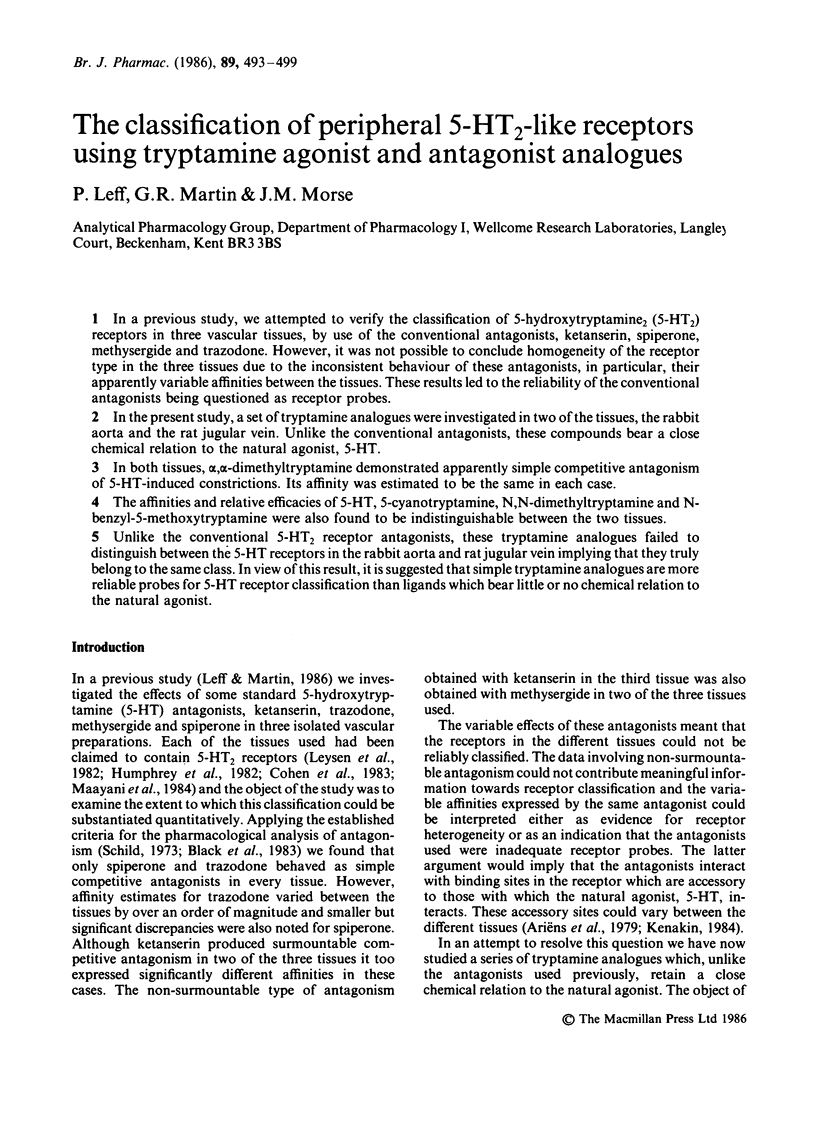
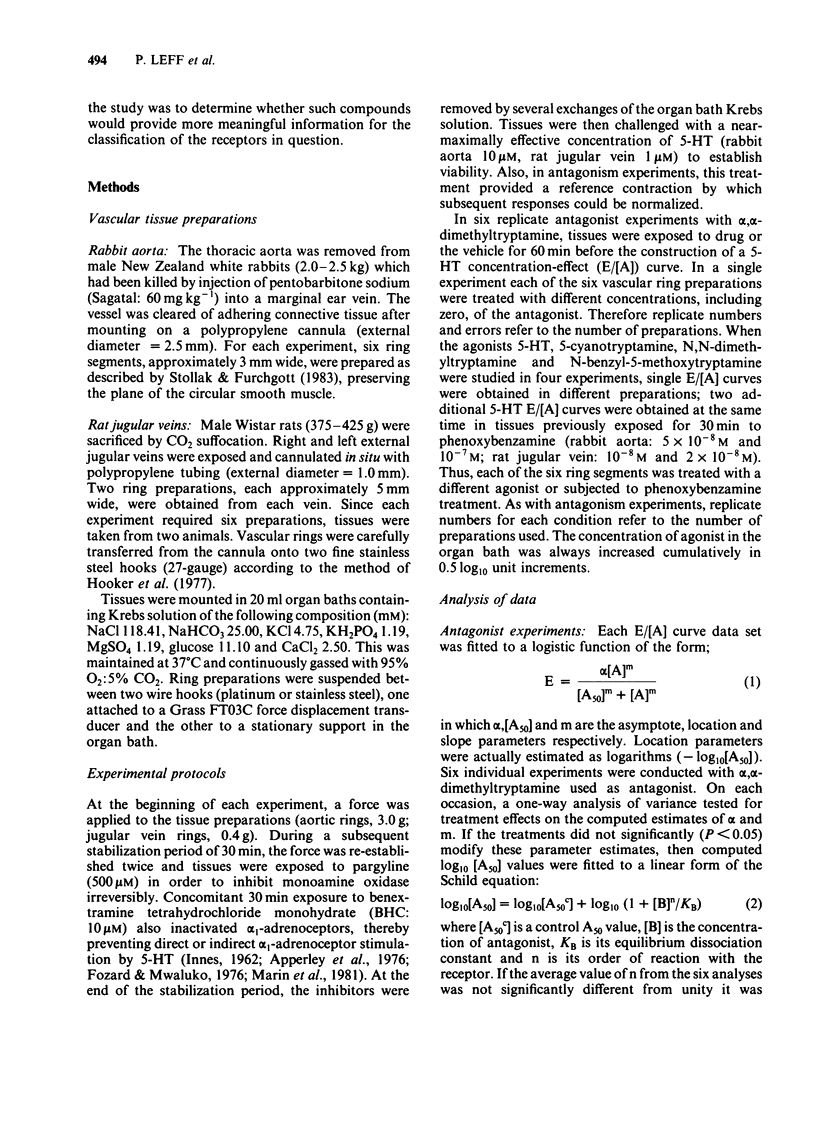
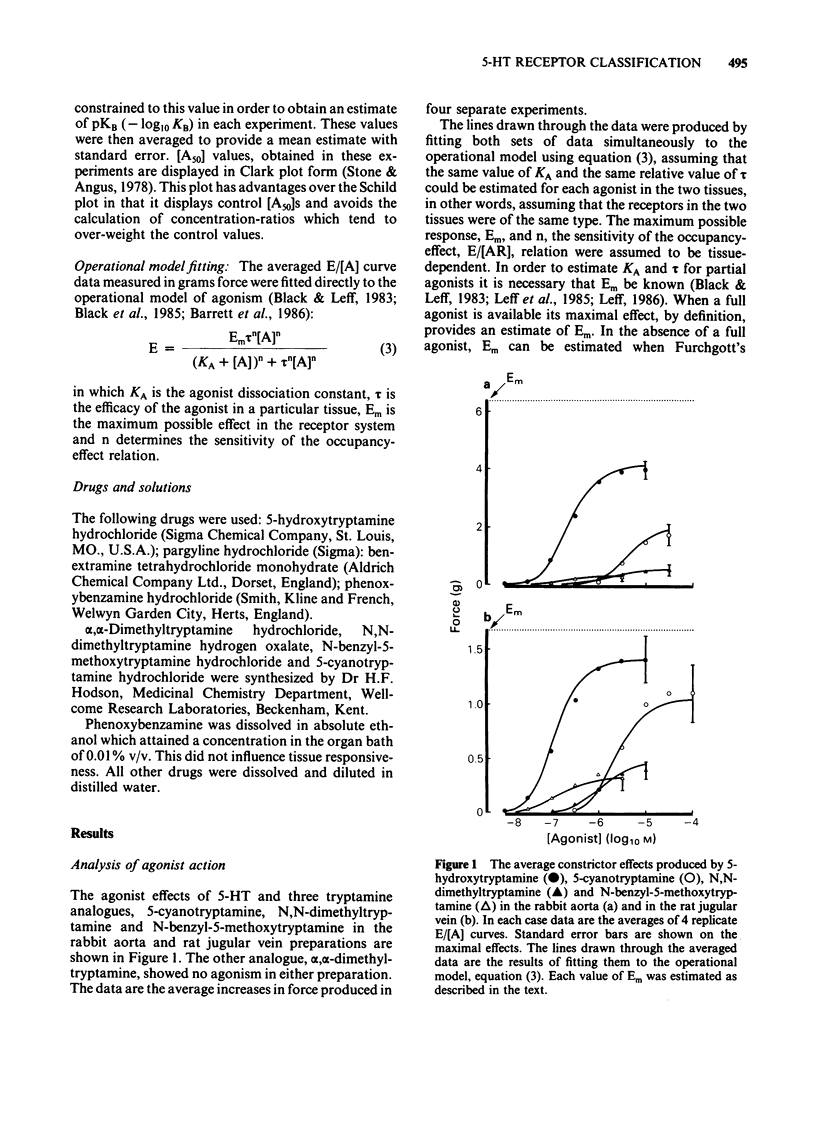

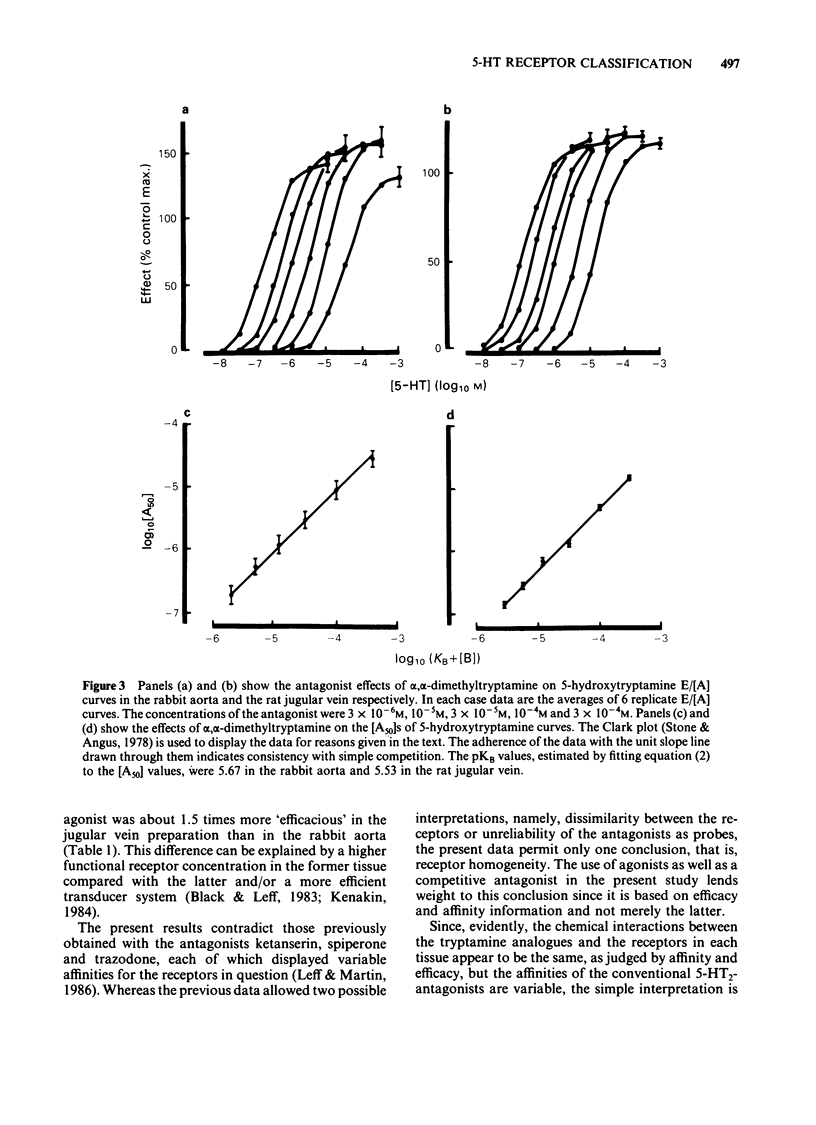
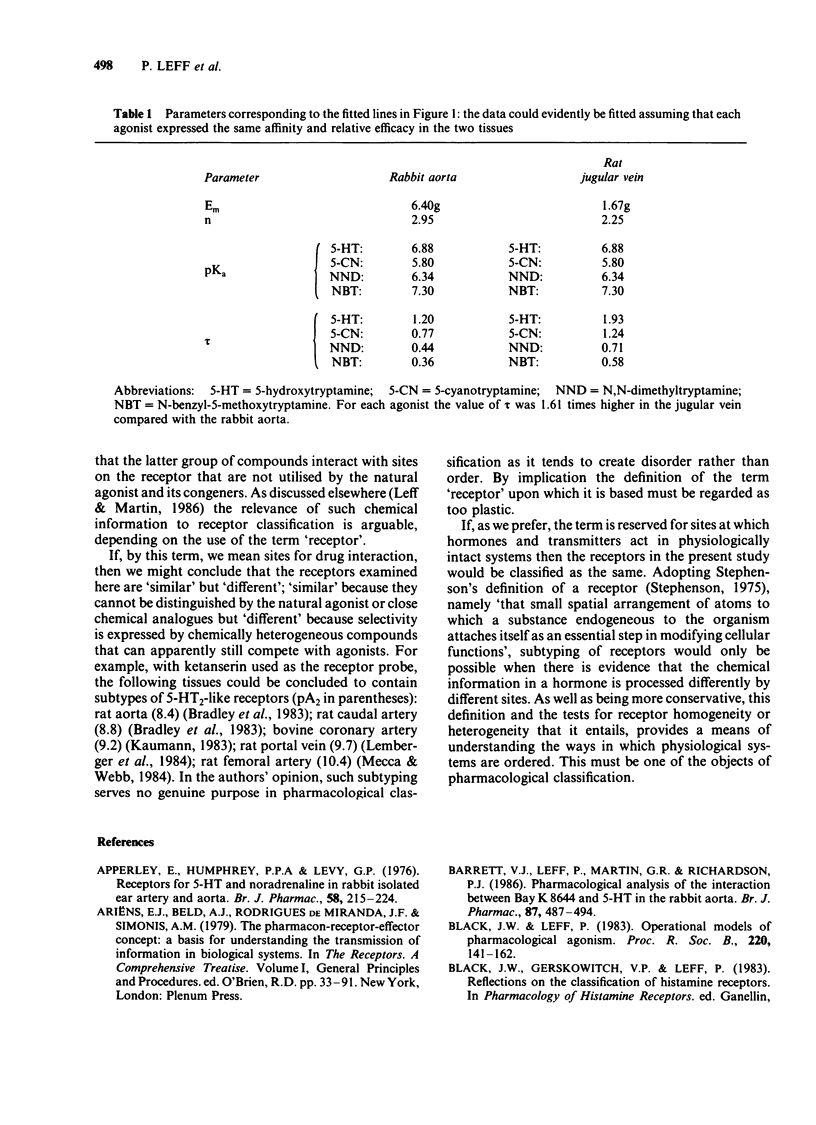
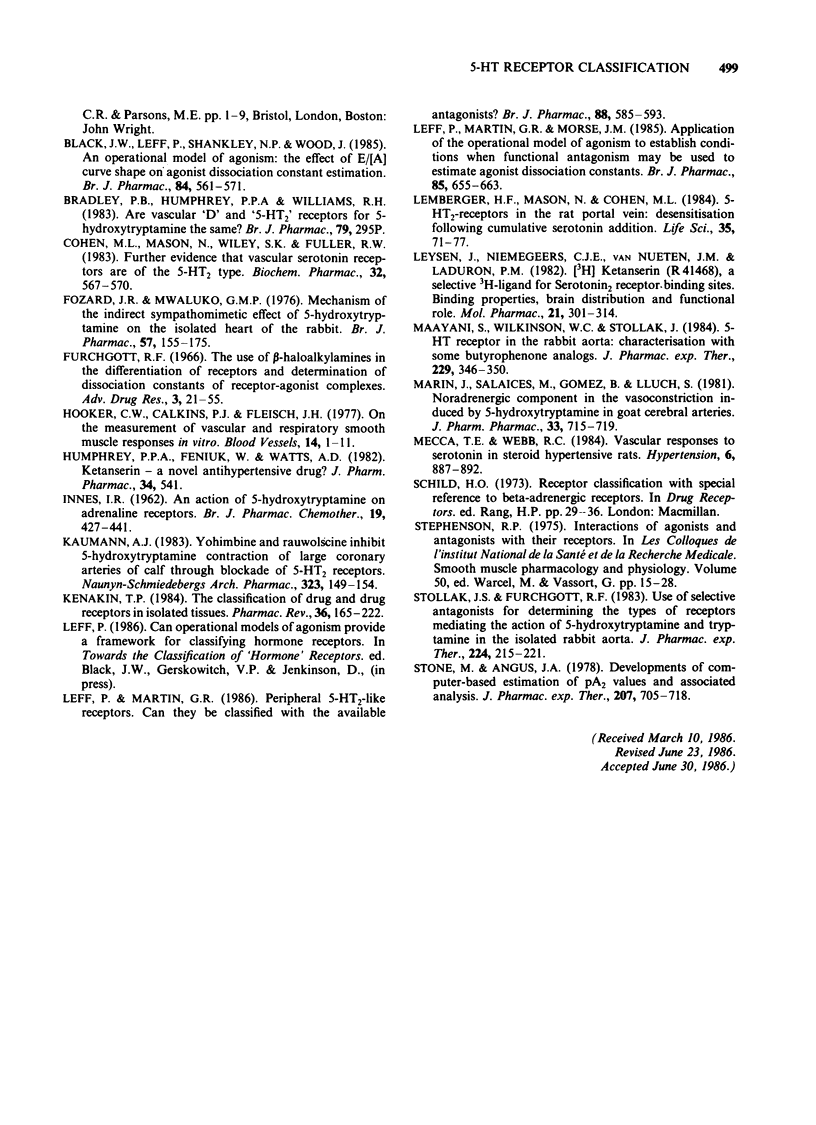
Selected References
These references are in PubMed. This may not be the complete list of references from this article.
- Barrett V. J., Leff P., Martin G. R., Richardson P. J. Pharmacological analysis of the interaction between Bay K 8644 and 5-HT in rabbit aorta. Br J Pharmacol. 1986 Mar;87(3):487–494. doi: 10.1111/j.1476-5381.1986.tb10190.x. [DOI] [PMC free article] [PubMed] [Google Scholar]
- Black J. W., Leff P. Operational models of pharmacological agonism. Proc R Soc Lond B Biol Sci. 1983 Dec 22;220(1219):141–162. doi: 10.1098/rspb.1983.0093. [DOI] [PubMed] [Google Scholar]
- Black J. W., Leff P., Shankley N. P., Wood J. An operational model of pharmacological agonism: the effect of E/[A] curve shape on agonist dissociation constant estimation. Br J Pharmacol. 1985 Feb;84(2):561–571. doi: 10.1111/j.1476-5381.1985.tb12941.x. [DOI] [PMC free article] [PubMed] [Google Scholar]
- Cohen M. L., Mason N., Wiley K. S., Fuller R. W. Further evidence that vascular serotonin receptors are of the 5HT2 type. Biochem Pharmacol. 1983 Feb 1;32(3):567–570. doi: 10.1016/0006-2952(83)90541-5. [DOI] [PubMed] [Google Scholar]
- Dreyfus C. F., Gershon M. D., Haymovits A., Nunez E. Calcitonin: antagonism at intestinal muscarinic receptors. Br J Pharmacol. 1976 May;57(1):155–157. doi: 10.1111/j.1476-5381.1976.tb07667.x. [DOI] [PMC free article] [PubMed] [Google Scholar]
- Hooker C. S., Calkins P. J., Fleisch J. H. On the measurement of vascular and respiratory smooth muscle responses in vitro. Blood Vessels. 1977;14(1):1–11. doi: 10.1159/000158110. [DOI] [PubMed] [Google Scholar]
- Humphrey P. P., Feniuk W., Watts A. D. Ketanserin--a novel antihypertensive drug? J Pharm Pharmacol. 1982 Aug;34(8):541–541. doi: 10.1111/j.2042-7158.1982.tb04788.x. [DOI] [PubMed] [Google Scholar]
- INNES I. R. An action of 5-hydroxytryptamine on adrenaline receptors. Br J Pharmacol Chemother. 1962 Dec;19:427–441. doi: 10.1111/j.1476-5381.1962.tb01447.x. [DOI] [PMC free article] [PubMed] [Google Scholar]
- Kaumann A. J. Yohimbine and rauwolscine inhibit 5-hydroxytryptamine-induced contraction of large coronary arteries of calf through blockade of 5 HT2 receptors. Naunyn Schmiedebergs Arch Pharmacol. 1983 Jun;323(2):149–154. doi: 10.1007/BF00634263. [DOI] [PubMed] [Google Scholar]
- Kenakin T. P. The classification of drugs and drug receptors in isolated tissues. Pharmacol Rev. 1984 Sep;36(3):165–222. [PubMed] [Google Scholar]
- Leff P., Martin G. R., Morse J. M. Application of the operational model of agonism to establish conditions when functional antagonism may be used to estimate agonist dissociation constants. Br J Pharmacol. 1985 Jul;85(3):655–663. doi: 10.1111/j.1476-5381.1985.tb10561.x. [DOI] [PMC free article] [PubMed] [Google Scholar]
- Leff P., Martin G. R. Peripheral 5-HT2-like receptors. Can they be classified with the available antagonists? Br J Pharmacol. 1986 Jul;88(3):585–593. doi: 10.1111/j.1476-5381.1986.tb10239.x. [DOI] [PMC free article] [PubMed] [Google Scholar]
- Lemberger H. F., Mason N., Cohen M. L. 5HT2 receptors in the rat portal vein: desensitization following cumulative serotonin addition. Life Sci. 1984 Jul 2;35(1):71–77. doi: 10.1016/0024-3205(84)90153-x. [DOI] [PubMed] [Google Scholar]
- Leysen J. E., Niemegeers C. J., Van Nueten J. M., Laduron P. M. [3H]Ketanserin (R 41 468), a selective 3H-ligand for serotonin2 receptor binding sites. Binding properties, brain distribution, and functional role. Mol Pharmacol. 1982 Mar;21(2):301–314. [PubMed] [Google Scholar]
- Maayani S., Wilkinson C. W., Stollak J. S. 5-Hydroxytryptamine receptor in rabbit aorta: characterization by butyrophenone analogs. J Pharmacol Exp Ther. 1984 May;229(2):346–350. [PubMed] [Google Scholar]
- Marin J., Salaices M., Gómez B., Lluch S. Noradrenergic component in the vasoconstriction induced by 5-hydroxytryptamine in goat cerebral arteries. J Pharm Pharmacol. 1981 Nov;33(11):715–719. doi: 10.1111/j.2042-7158.1981.tb13911.x. [DOI] [PubMed] [Google Scholar]
- Mecca T. E., Webb R. C. Vascular responses to serotonin in steroid hypertensive rats. Hypertension. 1984 Nov-Dec;6(6 Pt 1):887–892. doi: 10.1161/01.hyp.6.6.887. [DOI] [PubMed] [Google Scholar]
- Stollak J. S., Furchgott R. F. Use of selective antagonists for determining the types of receptors mediating the actions of 5-hydroxytryptamine and tryptamine in the isolated rabbit aorta. J Pharmacol Exp Ther. 1983 Jan;224(1):215–221. [PubMed] [Google Scholar]
- Stone M., Angus J. A. Developments of computer-based estimation of pA2 values and associated analysis. J Pharmacol Exp Ther. 1978 Dec;207(3):705–718. [PubMed] [Google Scholar]


